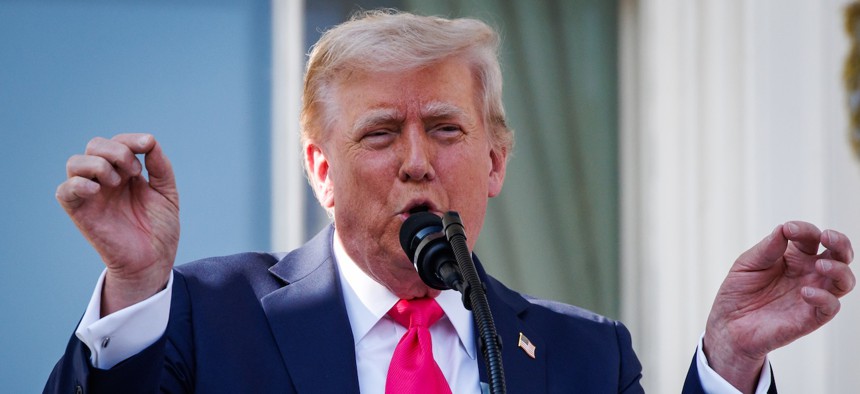
The freeze, which the president initially ordered on Jan. 20, the day he took office, prevents the hiring of civilian employees at federal agencies for either vacancies or new positions. Samuel Corum/Getty Images
Trump extends hiring freeze for 3 more months
Most agencies will now face a moratorium on hiring at least through mid-October after Trump issues his third freeze order.
President Trump on Monday extended his administration’s hiring freeze of all federal civilian positions for another three months, leaving in place the moratorium into the start of fiscal 2026.
The freeze, which the president initially ordered on Jan. 20, the day he took office, prevents the hiring of civilian employees at federal agencies for either vacancies or new positions. The initial executive order was set to run through April 20 and was subsequently extended until July 15.
As with previous orders, the freeze exempts positions related to immigration enforcement, national security or public safety, as well as the components of the Executive Office of the President. The order also reiterated that roles will be filled to protect the “provision of Social Security, Medicare, or veterans' benefits.” Despite the carveouts, the Defense Department continues to operate under a partial hiring freeze of its own for civilian personnel.
For the first time, there was no specific mention of the Internal Revenue Service. Trump had previously ordered IRS to face an indefinite hiring freeze.
Also exempt from the hiring freeze are political appointees hired through Schedule A or C of the excepted service, as well as any other non-career senior executives. Trump again stressed that contracting out work to circumvent the order would be prohibited.
Trump in his order said that any hiring that does occur should be consistent with his “merit hiring plan,” which has faced pushback for injecting politics into the process. The Office of Personnel Management has partially walked back the most controversial part of that plan—that applicants write an essay describing how they would help implement Trump’s policy priorites—saying hiring managers should deemphasize that element.
While several presidents have begun their administrations with hiring freezes, Trump is looking to extend that precedent by dragging out his moratorium for at least nine months. In his first term, Trump implemented a 79-day pause. That was similar to the approach President Reagan employed upon taking office. President Carter, however, froze federal hiring for the last nine months of his term.
The Trump administration is increasingly relying on attrition to shrink the size of the federal workforce—a goal administration officials consistently reiterate—as widespread layoffs have largely not taken place thanks to a court injunction. The Veterans Affairs Department announced on Monday it would not use reductions in force to cut staff, instead relying on attrition and separation incentives to reach a decreased goal of 30,000 reductions. Some agencies are still expected to quickly implement RIFs if the Supreme Court overturns the injunction.
The Trump administration last week boasted that it slashed the federal workforce by 23,000 employees by March 31, in just the first nine weeks since the president’s inauguration. If Trump eventually opts to lift his freeze, he has already required that only one-in-four vacancies get filled. Some of the carved out areas, such as components of the Homeland Security Department, will soon begin a massive hiring spree thanks to funding approved in the One Big Beautiful Bill Act.
Share your news tips with us:
Eric Katz: ekatz@govexec.com, Signal: erickatz.28
NEXT STORY: Trump admin faces multi-front pushback on reported plans to cut most of DHS intel bureau







